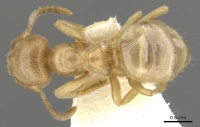Lasius mexicanus
| Lasius mexicanus | |
|---|---|

| |
| Scientific classification | |
| Kingdom: | Animalia |
| Phylum: | Arthropoda |
| Class: | Insecta |
| Order: | Hymenoptera |
| Family: | Formicidae |
| Subfamily: | Formicinae |
| Tribe: | Lasiini |
| Genus: | Lasius |
| Section: | flavus clade |
| Species group: | claviger |
| Species: | L. mexicanus |
| Binomial name | |
| Lasius mexicanus Wheeler, W.M., 1914 | |
| At a Glance | • Temporary parasite |
Identification
Keys including this Species
- Key to Lasius-Nearctic Acanthomyops males
- Key to Lasius-Nearctic Acanthomyops queens
- Key to Lasius-Nearctic Acanthomyops workers
- Key to North American Lasius Species
Distribution
Known from Hidalgo and Puebla, Mexico.
Latitudinal Distribution Pattern
Latitudinal Range: 24.52827° to 19.28°.
| North Temperate |
North Subtropical |
Tropical | South Subtropical |
South Temperate |
- Source: AntMaps
Distribution based on Regional Taxon Lists
Neotropical Region: Mexico (type locality).
Distribution based on AntMaps
Distribution based on AntWeb specimens
Check data from AntWeb
Countries Occupied
| Number of countries occupied by this species based on AntWiki Regional Taxon Lists. In general, fewer countries occupied indicates a narrower range, while more countries indicates a more widespread species. |

|
Estimated Abundance
| Relative abundance based on number of AntMaps records per species (this species within the purple bar). Fewer records (to the left) indicates a less abundant/encountered species while more records (to the right) indicates more abundant/encountered species. |

|
Biology
Wing (1968) – Type collections were made within a radius of a couple of miles of an ore mill, which was situated on the eastern slope of the high mountain range east of Pachuca. This country was covered with woods, mostly oaks and pines. The area around the mill was dry at certain times of the year; the altitude was between 8500 and 9000 feet. The type series includes specimens from more than one nest; all were collected from under large stones, mostly in pine woods. No habitat data other than altitude are available for the other two collections. The single queen was collected at 7900 feet, the nest of workers at 8600 feet.
Alate dates - The type alates were taken sometime during May 1913, while the Carney queen was collected June 16. This species begins its flights relatively early in the season.
This species is likely to be a temporary parasite, but its host is unknown.
Castes
Nomenclature
The following information is derived from Barry Bolton's Online Catalogue of the Ants of the World.
- mexicanus. Lasius (Acanthomyops) interjectus subsp. mexicanus Wheeler, W.M. 1914b: 55 (w.q.m.) MEXICO. Wheeler, G.C. & Wheeler, J. 1970: 648 (l.). Combination in Acanthomyops: Wing, 1968: 146; in Lasius: Ward, 2005: 13. Raised to species: Buren, 1950: 185.
Unless otherwise noted the text for the remainder of this section is reported from the publication that includes the original description.
Description
Worker
Wing (1968) – Closely similar to Lasius occidentalis, but petiolar scale broader, its width across spiracles clearly greater than height from spiracle to crest. Dorsum of gaster with pubescence dilute to moderate and long, its surface shining. In profile, propodeum usually distinctly convex. Posterior border of head as seen in full-face view straight or nearly so. Crest of petiolar scale usually emarginate, sides often convex.
Color yellow.
Queen
Wing (1968) – Similar to occidentalis, but posterior border of head as seen in full-face view straight or nearly so. Scutellum completely covered with long, dilute pubescence. Width of petiolar scale across spiracles clearly greater than height from spiracle to crest. Crest and sides of scale with fewer standing hairs. Pubescence over dorsum of gaster dilute, thinner on posterior surface than anteriorly. An occasional specimen may have pubescence moderate to moderately dense and more irregularly distributed. In all cases the gaster is at least moderately shiny. CI 100 or more.
Color brown to yellowish brown.
Male
Wing (1968) – Similar to occidentalis, but much larger; AL 1.40 mm or more, SL 0.60 mm or more. Scutellum entirely covered with dilute long pubescence. Pilosity at posterior tip of gaster with longer hairs measuring 0.20 mm or more. Petiolar scale broad, crest emarginate.
Pubescence on gaster dilute, surface shining. Body color brown, head darker, appendages lighter.
Type Material
Wing (1968) – Type locality: Guerrero Mill, State of Hidalgo, Mexico. Location of types: Syntypes in the Museum of Comparative Zoology.
References
- Buren, W. F. 1950. A new Lasius (Acanthomyops) with a key to North American females. Proc. Entomol. Soc. Wash. 52: 184-190 (page 185, Raised to species)
- Ward, P.S. 2005. A synoptic review of the ants of California (Hymenoptera: Formicidae). Zootaxa 936: 1-68 (page 13, revived combination in Lasius (Acanthomyops))
- Wheeler, G. C.; Wheeler, J. 1970b. Ant larvae of the subfamily Formicinae: second supplement. Ann. Entomol. Soc. Am. 63: 648-656 (page 648, larva described)
- Wheeler, W. M. 1914c. Ants collected by W. M. Mann in the state of Hidalgo, Mexico. J. N. Y. Entomol. Soc. 22: 37-61 (page 55, worker, queen, male described)
- Wing, M. W. 1968a. Taxonomic revision of the Nearctic genus Acanthomyops (Hymenoptera: Formicidae). Mem. Cornell Univ. Agric. Exp. Stn. 405: 1-173 (page 146, Combination in Acanthomyops)
References based on Global Ant Biodiversity Informatics
- Fernandes, P.R. XXXX. Los hormigas del suelo en Mexico: Diversidad, distribucion e importancia (Hymenoptera: Formicidae).
- Vásquez-Bolaños M. 2011. Lista de especies de hormigas (Hymenoptera: Formicidae) para México. Dugesiana 18: 95-133
- Wing M. W. 1968. Taxonomic revision of the Nearctic genus Acanthomyops (Hymenoptera: Formicidae). Memoirs of the Cornell University Agricultural Experiment Station 405: 1-173.


